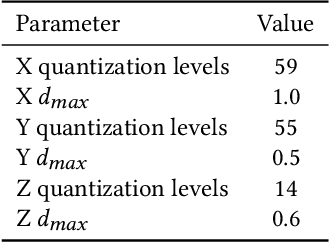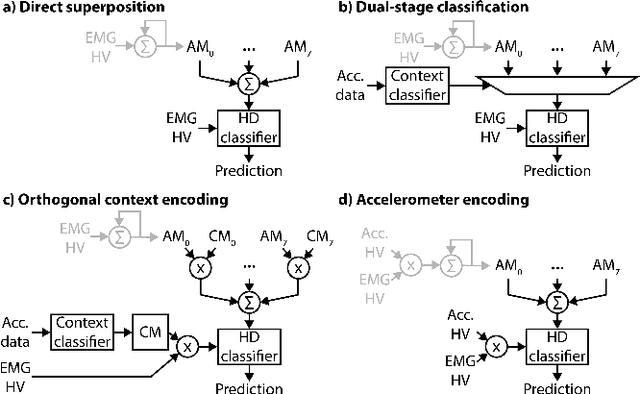Jan Rabaey
Memory-Efficient, Limb Position-Aware Hand Gesture Recognition using Hyperdimensional Computing
Mar 09, 2021



Abstract:Electromyogram (EMG) pattern recognition can be used to classify hand gestures and movements for human-machine interface and prosthetics applications, but it often faces reliability issues resulting from limb position change. One method to address this is dual-stage classification, in which the limb position is first determined using additional sensors to select between multiple position-specific gesture classifiers. While improving performance, this also increases model complexity and memory footprint, making a dual-stage classifier difficult to implement in a wearable device with limited resources. In this paper, we present sensor fusion of accelerometer and EMG signals using a hyperdimensional computing model to emulate dual-stage classification in a memory-efficient way. We demonstrate two methods of encoding accelerometer features to act as keys for retrieval of position-specific parameters from multiple models stored in superposition. Through validation on a dataset of 13 gestures in 8 limb positions, we obtain a classification accuracy of up to 93.34%, an improvement of 17.79% over using a model trained solely on EMG. We achieve this while only marginally increasing memory footprint over a single limb position model, requiring $8\times$ less memory than a traditional dual-stage classification architecture.
Sparse-Push: Communication- & Energy-Efficient Decentralized Distributed Learning over Directed & Time-Varying Graphs with non-IID Datasets
Feb 12, 2021



Abstract:Current deep learning (DL) systems rely on a centralized computing paradigm which limits the amount of available training data, increases system latency, and adds privacy and security constraints. On-device learning, enabled by decentralized and distributed training of DL models over peer-to-peer wirelessly connected edge devices, not only alleviate the above limitations but also enable next-gen applications that need DL models to continuously interact and learn from their environment. However, this necessitates the development of novel training algorithms that train DL models over time-varying and directed peer-to-peer graph structures while minimizing the amount of communication between the devices and also being resilient to non-IID data distributions. In this work we propose, Sparse-Push, a communication efficient decentralized distributed training algorithm that supports training over peer-to-peer, directed, and time-varying graph topologies. The proposed algorithm enables 466x reduction in communication with only 1% degradation in performance when training various DL models such as ResNet-20 and VGG11 over the CIFAR-10 dataset. Further, we demonstrate how communication compression can lead to significant performance degradation in-case of non-IID datasets, and propose Skew-Compensated Sparse Push algorithm that recovers this performance drop while maintaining similar levels of communication compression.
 Add to Chrome
Add to Chrome Add to Firefox
Add to Firefox Add to Edge
Add to Edge